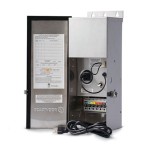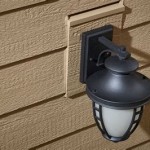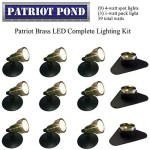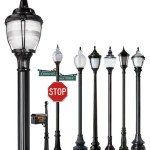Wireless Outdoor Security Lights With Sensor: Enhancing Home Security and Convenience
Wireless outdoor security lights with sensors have become increasingly popular as a practical and efficient way to deter unwanted activity and provide enhanced safety around residential and commercial properties. These lights offer the benefit of easy installation without the need for complex wiring, coupled with the intelligence of motion detection technology. By illuminating dark areas automatically when movement is detected, they effectively discourage potential intruders and provide a sense of security for homeowners. This article delves into the various aspects of wireless outdoor security lights with sensors, exploring their features, benefits, types, installation considerations, and maintenance requirements.
The fundamental principle behind these lights is the combination of two key technologies: wireless connectivity and sensor-based activation. Wireless connectivity allows the lights to operate without a direct wired connection to the electrical grid, relying instead on batteries or solar power and communicating wirelessly with a central hub or directly with a smartphone app. The sensor component, typically a passive infrared (PIR) sensor or a microwave sensor, detects movement within a defined range and triggers the light to activate. This automatic activation is a significant advantage over traditional manually operated outdoor lights.
Key Features and Benefits
Wireless outdoor security lights with sensors offer a range of features and benefits that contribute to their widespread adoption. These lights provide both practical illumination and a deterrent to potential criminal activity. Among the most prominent advantages are ease of installation, energy efficiency, enhanced security, and convenient automation.
Ease of Installation: Traditional outdoor lighting often requires professional installation due to the need for wiring and electrical connections. Wireless security lights, however, are designed for easy, do-it-yourself (DIY) installation. Typically, the process involves mounting the light fixture using screws or adhesive pads. Since there is no need to run wires, installation can be completed quickly and without the expense of hiring an electrician. This makes them a particularly attractive option for homeowners who are not comfortable with electrical work or who live in properties where running new wiring is difficult or impractical.
Energy Efficiency: Many wireless outdoor security lights utilize LED (Light Emitting Diode) technology, which is significantly more energy-efficient than traditional incandescent or halogen bulbs. LEDs consume less power to produce the same amount of light, resulting in lower electricity bills. Additionally, the sensor-activated nature of these lights means they only turn on when needed, further conserving energy. Some models are also equipped with solar panels, which harness sunlight to charge the batteries, eliminating the need for external power sources and minimizing environmental impact.
Enhanced Security: The primary function of security lights is to deter crime, and wireless outdoor lights with sensors excel in this regard. The sudden illumination of a dark area can startle and discourage potential intruders. Furthermore, the lights can be strategically placed to eliminate blind spots and create well-lit pathways around the property, making it more difficult for criminals to approach unseen. Some advanced models offer additional security features, such as built-in cameras, two-way audio communication, and connectivity to home security systems, providing comprehensive surveillance and deterrence capabilities.
Convenient Automation: The sensor-based activation of these lights provides a high level of convenience. Homeowners do not need to manually turn the lights on and off, as the lights automatically illuminate when motion is detected. This is particularly useful for areas such as driveways, walkways, and backyards, where people may be carrying items or simply want to avoid fumbling for a light switch in the dark. The convenience extends to remote control capabilities available with some models, allowing users to adjust settings, view live feeds, and receive alerts via a smartphone app.
Types of Wireless Outdoor Security Lights With Sensor
The market offers a diverse range of wireless outdoor security lights with sensors, each designed to cater to specific needs and preferences. They can be broadly categorized based on their power source, sensor type, and features. Understanding these distinctions is crucial for selecting the most appropriate lights for a particular application.
Battery-Powered Lights: These lights rely on batteries as their primary power source. They are typically easy to install and require no wiring, making them suitable for locations where access to electricity is limited. The battery life can vary depending on the type of battery used (e.g., alkaline, lithium-ion) and the frequency of activation. Some models offer rechargeable batteries, which can be replaced or recharged as needed. While battery-powered lights offer convenience, they may require periodic battery replacements, which can add to the overall cost.
Solar-Powered Lights: Solar-powered lights utilize photovoltaic cells to convert sunlight into electricity, which is then stored in rechargeable batteries. These lights are environmentally friendly and require no external power source. They are ideal for locations with ample sunlight. The performance of solar-powered lights can be affected by weather conditions, such as cloudy days or shade. However, advancements in solar technology have improved the efficiency and reliability of these lights, making them a viable option for many applications.
PIR Sensor Lights: Passive Infrared (PIR) sensors detect changes in infrared radiation, which is emitted by warm objects, such as humans and animals. These sensors are commonly used in security lights due to their relatively low cost and reliable performance. PIR sensors are sensitive to temperature fluctuations and may be prone to false alarms in certain environments, such as areas with strong winds or direct sunlight. However, manufacturers have implemented various techniques to mitigate these issues, such as adjustable sensitivity settings and shielding the sensor from direct sunlight.
Microwave Sensor Lights: Microwave sensors emit microwave radiation and detect changes in the reflected signal. They are generally more sensitive than PIR sensors and can detect movement through walls and other obstacles. Microwave sensors are less susceptible to temperature fluctuations and are less likely to trigger false alarms. However, they may be more expensive than PIR sensors and can be affected by interference from other electronic devices.
Installation Considerations and Best Practices
Proper installation is essential for ensuring the optimal performance and longevity of wireless outdoor security lights with sensors. Factors such as location, mounting height, and sensor settings should be carefully considered during the installation process.
Location: The placement of security lights should be strategic, focusing on areas that are vulnerable to intrusion or require illumination for safety. Common locations include entryways, driveways, walkways, backyards, and garages. Lights should be positioned to cover a wide area and eliminate blind spots. Avoid placing lights near trees or shrubs that could obstruct the sensor's field of view or trigger false alarms due to movement caused by wind.
Mounting Height: The optimal mounting height for security lights depends on the sensor type and the desired coverage area. Generally, PIR sensor lights should be mounted at a height of 6 to 10 feet to maximize their detection range. Microwave sensor lights can be mounted at higher elevations due to their ability to detect movement through obstacles. Ensure the mounting surface is sturdy and capable of supporting the weight of the light fixture. Follow the manufacturer's instructions for specific mounting recommendations.
Sensor Settings: Most wireless outdoor security lights with sensors offer adjustable settings for sensitivity, detection range, and illumination duration. The sensitivity setting determines the level of movement required to trigger the light. A higher sensitivity setting will detect smaller movements, while a lower setting will require larger movements. The detection range determines the distance at which the sensor can detect movement. The illumination duration determines how long the light will remain on after being triggered. Adjusting these settings to suit the specific environment and needs can help minimize false alarms and optimize energy efficiency.
Testing and Adjustments: After installation, thoroughly test the security lights to ensure they are functioning correctly. Walk around the area covered by the sensor to verify that the light is triggered when movement is detected. Adjust the sensor settings as needed to achieve the desired performance. Periodically check the batteries or solar panels to ensure they are functioning properly. Regular maintenance, such as cleaning the lens and sensor, can help maintain optimal performance.
In summary, wireless outdoor security lights with sensors provide a convenient, effective, and energy-efficient way to enhance home security and improve safety around the property. The ease of installation, combined with the intelligent automation of motion detection, makes them a popular choice for homeowners seeking to protect their property and loved ones. By carefully considering the various types of lights, installation considerations, and maintenance requirements, individuals can select and implement the most appropriate security lighting solution for their specific needs.

Le Solar Lights Outdoor Motion Sensor Security 3 Adjustable Head 70 Led 270 Wide Angle Waterproof Wireless Wall For Porch Yard Garage Pathway And More

Buy Svk Dream 100 Led Bright Outdoor Security Lights With Motion Sensor Solar Powered Wireless Waterproof Night Spotlight For Garden Wall Home 1 At Best S In

Best Outdoor Motion Sensor Lights 2024 Security

Le Solar Lights Outdoor Motion Sensor Security 3 Adjustable Head 70 Led 270 Wide Angle Waterproof Wireless Wall For Porch Yard Garage Pathway And More

Solar Lights Outdoor 210led 2500lm Motion Sensor Security With Wireless Remote Control Waterproof 3 Heads Led Flood Wall For Porch Garage Yard Entryways Patio 1pack Com

Outdoor Led Solar Light White 800 Lumens Motion Sensor Wireless 6 Modes Adjustable Angle With Flood Lights Detector Security Lighting For Parking Lot Porch Gar China Street

Jesto Pig Led Solar Lights Outdoor Waterproof Powered Motion Sensor Light Wireless Security Outsi Hktvmall The Largest Hk Ping Platform

Wireless Outdoor Security Lights Light

9 Best Security Lights With Motion Sensor Deluxe House

Torchstar 20 Led Outdoor Solar Motion Sensor Lights Wireless Security White 2 Pack Com
Related Posts







